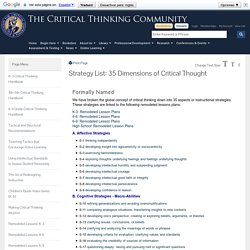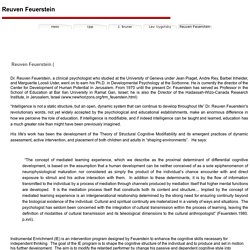

IdeaConnection: Solve your open innovation challenges. Creative Education Foundation (CEF) - Where Brainstorming Began. Strategy List: 35 Dimensions of Critical Thought. S-1 Thinking Independently Principle: Critical thinking is independent thinking, thinking for oneself.

Many of our beliefs are acquired at an early age, when we have a strong tendency to form beliefs for irrational reasons (because we want to believe, because we are praised or rewarded for believing). Critical thinkers use critical skills and insights to reveal and reject beliefs that are irrational. In forming new beliefs, critical thinkers do not passively accept the beliefs of others; rather, they try to figure things out for themselves, reject unjustified authorities, and recognize the contributions of genuine authorities. They thoughtfully form principles of thought and action; they do not mindlessly accept those presented to them.
If they find that a set of categories or distinctions is more appropriate than that used by another, they will use it. Independent thinkers strive to incorporate all known relevant knowledge and insight into their thought and behavior. Go to top. Agency for Social Media is the leading provider of complete social media solutions. All we want is your success. ScientificThinkingProcess. Presentation-stateofart-belgium. Reuven Feuerstein. Dr.

Reuven Feuerstein, a clinical psychologist who studied at the University of Geneva under Jean Piaget, Andre Rey, Barbel Inhelder, and Marguerite Loosli Uster, went on to earn his Ph.D. in Developmental Psychology at the Sorbonne. He is currently the director of the Center for Development of Human Potential in Jerusalem. From 1970 until the present Dr. Feuerstein has served as Professor in the School of Education at Bar Ilan University in Ramat Gan, Israel; he is also the Director of the Hadassah-Wizo-Canada Research Institute, in Jerusalem, Israel (www.newhorizons.org/trm_feuerstein.html) “Intelligence is not a static structure, but an open, dynamic system that can continue to develop throughout life” Dr.
His life's work has been the development of the Theory of Structural Cognitive Modifiability and its emergent practices of dynamic assessment, active intervention, and placement of both children and adults in “shaping environments”. The Theory and Practice of Mediated Learning Experience Introduction. The Theory and Practice of Mediated Learning Experience Introduction Mediated Learning Experience (MLE) describes a special quality of interaction between a learner and a person, whom we shall call a "mediator". The function of a mediator is different from that of a teacher, as illustrated by the following two diagrams. In this mode the teacher provides a suitable stimulus (homework, test, assignment, etc.) and then observes the response of the learner to the stimulus. Based on the response, the teacher interacts with the learner (praise, criticism, encouragement, grade, new assignment, for example) and the process is continued until either the teacher or the learner is satisfied or time runs out.
Teachers develop their own repertoire of methods depending upon the siz e of the class, the apparent ability of the learner(s) and the subject matter. The intentionality of the mediator is different from that of a teacher. 1. We have explained intentionality above. 2. 3.